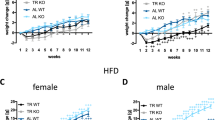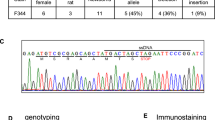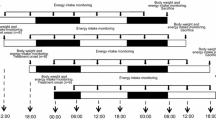Abstract
This study examined changes in neuropeptide Y (NPY) Y2 receptor binding in the brains of C57BL/6 mice in response to different levels of high-fat diets via three dietary intervention methods: high-fat diet, switching from high- to low-fat diet and finally, energy restricted high-fat diet. Forty-five C57Bl/6 male mice were fed a high-fat diet for 8 weeks and then classified as diet-induced obese (DIO) or diet-resistant (DR) mice according to the highest and lowest body weight gainers, respectively. The DIO and DR mice were then randomly divided into three groups each and either continued on their high-fat diet ad libitum (DIO-H and DR-H), changed to a low-fat diet (DIO-L and DR-L) or pair-fed via energy restricted high-fat diet (DIO-P and DR-P) for a further 6 weeks. During the course of this study, body weight, energy intake and plasma peptide YY (PYY) were measured. The study revealed that the replacement of a high-fat diet with a low-fat diet was associated with a significant lowering of ventromedial hypothalamic (VMH) Y2 receptor binding in both the DIO-L and DR-L mice (−37%, −36%), and also a lowered plasma PYY level in the DIO-L mice (−25%). Despite a continued consumption of the high-fat diet, energy restricted pair feeding caused a lower VMH Y2 receptor binding in the obese mice (DIO-P) following weight loss compared to the DR-P mice (−14%). In conclusion, this study showed that changing diets from high- to low-fat can significantly lower the VMH Y2 receptor binding irrespective to the obesity phenotype. Energy restriction, even while on high-fat feeding, can cause a lower VMH Y2 receptor binding compared to DR mice even after body weight loss to similar levels. This suggests either a possible intrinsic nature of the DIO mice or a body weight set-point re-establishment to drive body weight regain.



Similar content being viewed by others
References
Dube MG, Xu B, Kalra PS, Sninsky CA, Kalra SP (1999) Disruption in neuropeptide Y and leptin signaling in obese ventromedial hypothalamic-lesioned rats. Brain Res 816:38–46
Kalra SP, Dube MG, Pu S, Xu B, Horvath TL, Kalra PS (1999) Interacting appetite-regulating pathways in the hypothalamic regulation of body weight. Endocr Rev 20:68–100
Bray GA (1984) Syndromes of hypothalamic obesity in man. Pediatr Ann 13:525–536
King BM (2006) The rise, fall, and resurrection of the ventromedial hypothalamus in the regulation of feeding behavior and body weight. Physiol Behav 87:221–244
Ruffin M-P, Nicolaidis S (1999) Electrical stimulation of the ventromedial hypothalamus enhances both fat utilization and metabolic rate that precede and parallel the inhibition of feeding behavior. Brain Res 846:23–29
Oku J, Bray GA, Fisler JS, Schemmel R (1984) Ventromedial hypothalamic knife-cut lesions in rats resistant to dietary obesity. Am J Physiol Regul Integr Comp Physiol 246:R943–R948
Stanley BG, Kyrkouli SE, Lampert S, Leibowitz SF (1986) Neuropeptide Y chronically injected into the hypothalamus: a powerful neurochemical inducer of hyperphagia and obesity. Peptides 7:1189–1192
Kalra SP, Dube MG, Sahu A, Phelps CP, Kalra PS (1991) Neuropeptide Y secretion increases in the paraventricular nucleus in association with increased appetite for food. Proc Natl Acad Sci U S A 88:10931–10935
Michel MC, Beck-Sickinger A, Cox H, Doods HN, Herzog H, Larhammar D, Quirion R, Schwartz T, Westffall T (1998) International union of pharmacology recommendations for the nomenclature of neuropeptide Y, peptide YY, and pancreatic polypeptide receptors. Pharmacol Rev 50:143–150
Dumont Y, Jacques D, St-Pierre JA, Tong Y, Parker R, Herzog H, Quirion R (2000) Neuropeptide Y, peptide YY and pancreatic polypeptide receptor proteins and mRNAs in mammalian brains. In: Quirion R, Bjorkland A, Hokfelt T (eds) Handbook of chemical neuroanatomy, vol 16. Elsevier, pp 375–475
Parker E, Van Heek M, Stamford A (2002) Neuropeptide Y receptors as targets for anti-obesity drug development: perspective and current status. Eur J Pharmacol 440:173–187
Gerald C, Walker MW, Criscione L, Gustafson EL, Batzl HC, Smith KE, Vaysse P, Durkin MM, Laz TM, Linemeyer DL, Schaffhauser AO, Whitebread S, Hofbauer KG, Taber RI, Branchek TA, Weinshank RL (1996) A receptor subtype involved in neuropeptide-Y-induced food intake [see comments]. Nature 382:168–171
Herzog H, Baumgartner M, Vivero C, Selbie LA, Auer B, Shine J (1993) Genomic organization, localization, and allelic differences in the gene for the human neuropeptide Y Y1 receptor. J Biol Chem 268:6703–6707
Batterham RL, Cowley MA, Small CJ, Herzog H et al (2002) Gut hormone PYY3–36 physiologically inhibits food intake. Nature 418:650–654
Naveilhan P, Hassani H, Canals JM, Ekstrand AJ, Larefalk A, Chhajlani V, Arenas E, Gedda K, Svensson L, Thoren P et al (1999) Normal feeding behavior, body weight and leptin response require the neuropeptide Y Y2 receptor. Nat Med 5:1188–1193
Sainsbury A, Schwarzer C, Couzens M, Fetissov S, Furtinger S, Jenkins A, Cox HM, Sperk G, Hokfelt T, Herzog H (2002) Important role of hypothalamic Y2 receptors in body weight regulation revealed in conditional knockout mice. PNAS 99:8938–8943
Adrian TE, Long RG, Fuessl HS, Bloom SR (1985) Plasma peptide YY (PYY) in dumping syndrome. Dig Dis Sci 30:1145–1148
Adrian TE, Ferri GL, Bacarese-Hamilton AJ, Fuessl HS, Polak JM, Bloom SR (1985) Human distribution and release of a putative new gut hormone, peptide YY. Gastroenterology 89:1070–1077
Lynch DR, Walker MW, Miller RJ, Snyder SH (1989) Neuropeptide Y receptor binding sites in rat brain: differential autoradiographic localizations with 125I-peptide YY and 125I-neuropeptide Y imply receptor heterogeneity. J Neurosci 9:2607–2619
Batterham RL, Bloom SR (2003) The gut hormone peptide YY regulates appetite in Melanocortin System. Ann N Y Acad Sci 994:162–168
Xin X, Storlien LH, Huang X-F (2000) Hypothalamic c-fos-like immunoreactivity in high-fat diet-induced obese and resistant mice. Brain Res Bull 52:235–242
Levin BE, Keesey RE (1998) Defense of differing body weight set points in diet-induced obese and resistant rats. Am J Physiol 274:R412–R419
Huang X-F, Han M, Storlien LH (2003) The level of NPY receptor mRNA expression in diet-induced obese and resistant mice. Mol Brain Res 115:21–28
Caberlotto L, Fuxe K, Rimland JM, Sedvall G, Hurd YL (1998) Regional distribution of neuropeptide Y Y2 receptor messenger RNA in the human post mortem brain. Neuroscience 86:167–178
Huang XF, Deng C, Zavitsanou K (2006) Neuropeptide Y mRNA expression levels following chronic olanzapine, clozapine and haloperidol administration in rats. Neuropeptides 40:213–219
Reeves P, Forrest H, Nielsen H, Fahey G (1993) AIN-93 purified diets for laboratory rodents: final report of the American Institute of Nutrition Ad Hoc writing committee on the reformulation of the AIN-76A rodent diet. J Nutr 123:1939–1951
Huang XF, Han M, Storlien L (2004) Differential expression of 5-HT2A and 5-HT2C receptor mRNA in mice prone, or resistant, to chronic high-fat diet-induced obesity. Mol Brain Res 127:39–47
Levin BE, Keesey RE (1998) Defense of differing body weight set points in diet-induced obese and resistant rats. Am J Physiol 274:R412–R419
Lin S, Boey D, Couzens M, Lee N, Sainsbury A, Herzog H (2005) Compensatory changes in [125I]-PYY binding in Y receptor knockout mice suggest the potential existence of further Y receptor(s). Neuropeptides 39:21–28
Huang XF, Han M, Storlien LH (2003) The level of NPY receptor mRNA expression in diet-induced obese and resistant mice. Brain Res Mol Brain Res 115:21–28
Paxinos G, Franklin KBJ (2003) The mouse brain in stereotaxic coordinates, 2nd edn. Academic Press: Sydney
Huang XF, Xin X, McLennan P, Storlien L (2004) Role of fat amount and type in ameliorating diet-induced obesity: insights at the level of hypothalamic arcuate nucleus, leptin receptor, neuropeptide Y and pro-opiomelanocortin mRNA expression. Diabetes, Obes Metab 6:35–45
Surwit RS, Feinglos MN, Rodin J, Sutherland A, Petro AE, Opara EC, Kuhn CM, Rebuffe-Scrive M (1995) Differential effects of fat and sucrose on the development of obesity and diabetes in C57BL/6J and A/J mice. Metabolism 44:645–651
Petro AE, Cotter J, Cooper DA, Peters JC, Surwit SJ, Surwit RS (2004) Fat, carbohydrate, and calories in the development of diabetes and obesity in the C57BL/6J mouse. Metab Clin Exp 53:454–457
Chen X, Dimaggio DA, Han SP, Westfall TC (1997) Autoreceptor-induced inhibition of neuropeptide Y release from PC-12 cells is mediated by Y2 receptors. Am J Physiol Heart Circ Physiol 273:H1737–H1744
Nishimura F, Nishihara M, torii K, Takahashi M (1996) Changes in responsiveness to serotonin on rat ventromedial hypothalmic neurons after food deprivation. Physiol Behav 60:7–12
Morley JE, Levine AS, Gosnell BA, Kneip J, Grace M (1987) Effect of neuropeptide Y on ingestive behaviors in the rat. Am J Physiol 252:R599–R609
Lin HC, Chey WY (2003) Cholecystokinin and peptide YY are released by fat in either proximal or distal small intestine in dogs. Regul Pept 114:131–135
Chen CH, Rogers RC (1997) Peptide YY and the Y2 agonist PYY-(13–36) inhibit neurons of the dorsal motor nucleus of the vagus. Am J Physiol Regul Integr Comp Physiol 273:R213–R218
le Roux CW, Batterham RL, Aylwin SJB, Patterson M, Borg CM, Wynne KJ, Kent A, Vincent RP, Gardiner J, Ghatei MA, Bloom SR (2006) Attenuated peptide YY release in obese subjects is associated with reduced satiety. Endocrinology 147:3–8
Batterham RL, Cohen MA, Ellis SM, Le Roux CW, Withers DJ, Frost GS, Ghatei MA, Bloom SR (2003) Inhibition of food intake in obese subjects by peptide YY3-36. N Engl J Med 349:941–948
Acknowledgements
We wish to thank Prof. L. Storlien for his critical reading of the manuscript, Ms Kelly Newell for careful editorial reading and A/Prof. K. Russell (Department of Applied Statistics, University of Wollongong) for his suggestions regarding the statistical analysis. This study was supported by grants from the National Health and Medical Research Council of Australia, and AstraZeneca, Mölndal, Sweden.
Author information
Authors and Affiliations
Corresponding author
Rights and permissions
About this article
Cite this article
Huang, XF., Yu, Y., Li, Y. et al. Ventromedial Hypothalamic NPY Y2 Receptor in the Maintenance of Body Weight in Diet-Induced Obesity in Mice. Neurochem Res 33, 1881–1888 (2008). https://doi.org/10.1007/s11064-008-9661-5
Received:
Accepted:
Published:
Issue Date:
DOI: https://doi.org/10.1007/s11064-008-9661-5




